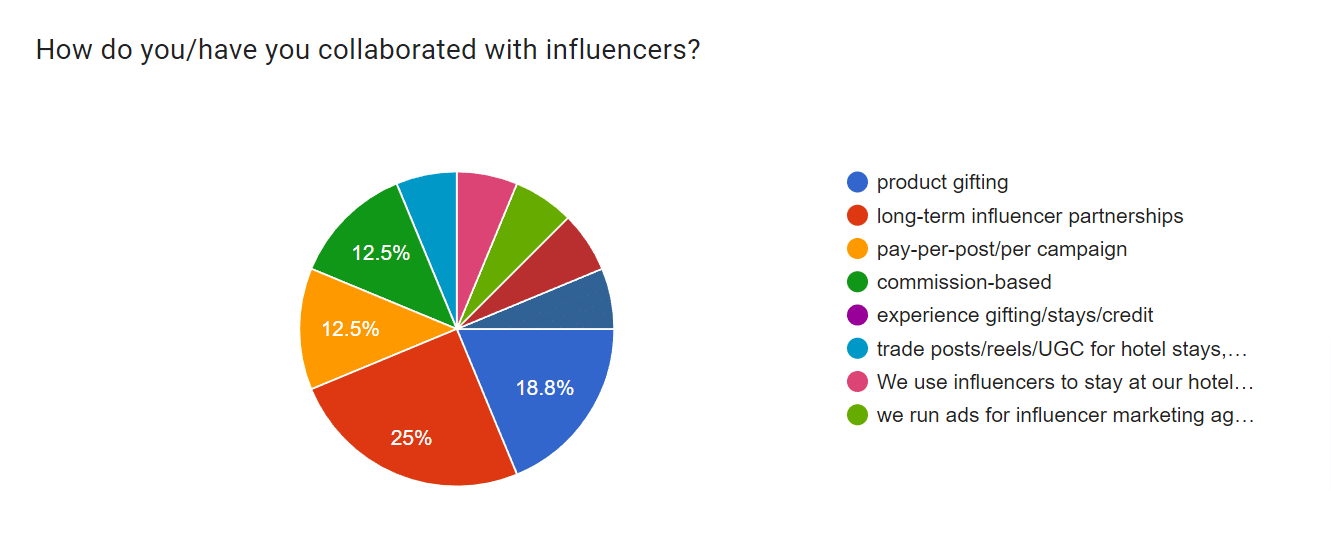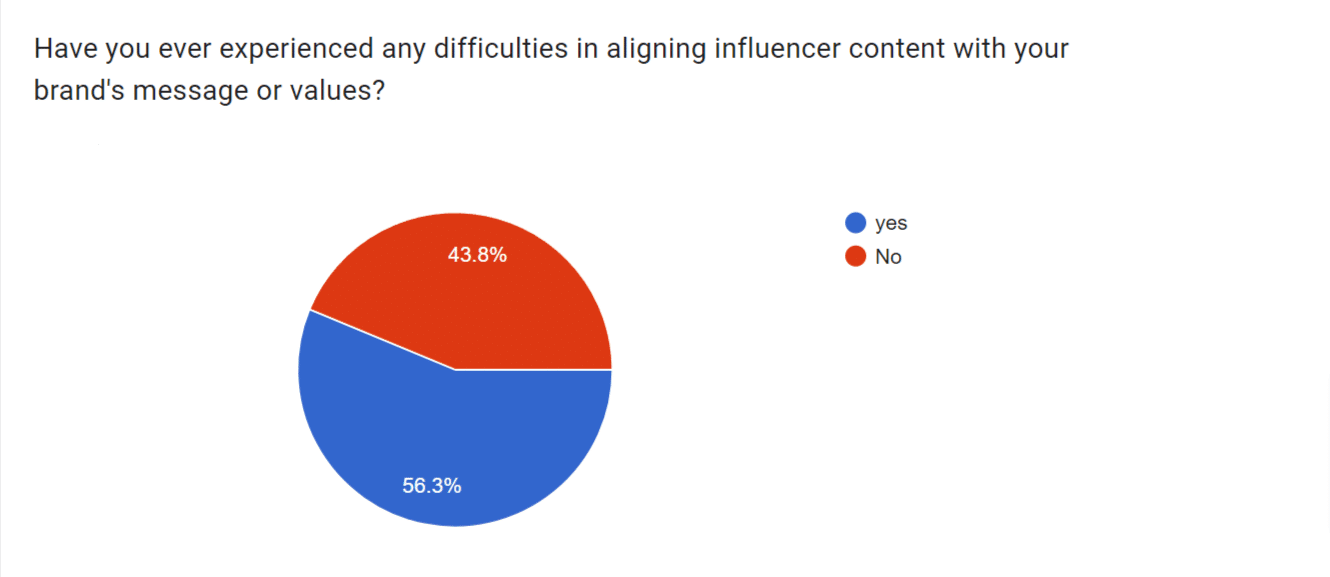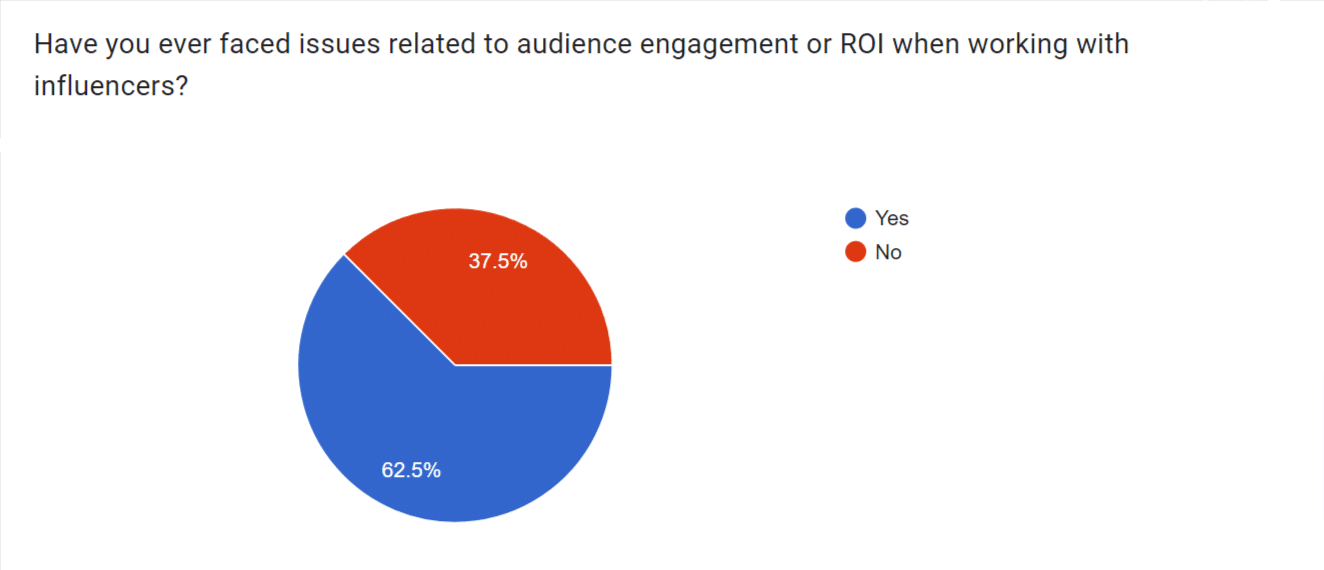We conducted a survey to uncover insights from marketing executives at medium and large-sized brands who have executed influencer marketing programs, in order to distill lessons learned.
Here, we’ve summarized the takeaways on the following:
- The most common types of influencer-brand partnerships
- The difficulty level of aligning influencer content with a brand’s message
- Five lessons learned from marketing executives of brands on influencer marketing strategy
What are the most common influencer-brand partnerships
The most common influencer-brand partnerships were:
- Long-term influencer partnerships (25%)
- Product gifting (18.8%)

But pay-per-post and commission-based influencer marketing came tied at 12.5% each.
Aligning influencer content with a brand’s message
The majority of executives have had difficulties aligning influencer content with their brand’s message and values:

When we asked our contributors to explain some context behind the difficulties encountered with influencers, we found varying experiences across the board.
According to Shane Keener, VP of Marketing at Stanford Hotels,
Keener added that “creators will use their own aesthetic or Point of View (POV) without concern for a brand or requested results”
Of course, this can be concerning if the influencer is a direct representation of your brand.
And when the audience or creative is off, so will be the Return on Investment (ROI). See here:

We noticed that the same contributors who expressed concern with creative and brand messaging alignment also expressed concern with ROI from their influencer partnerships.
The 37.5% of brand executives who did not have issues with seeing ROI also seemed to be pleased with the creator’s content as it related to their brand messaging and values.
Don Barnett, Director of Sales and Marketing at LondonHouse Chicago, also suggested that some of their ROI issues were interlaced with content quality and under-delivery:
While not all ROI-related issues are by any means a direct result of poor creative, it was certainly a common problem amongst many executives.
Five lessons learned from marketing executives of brands on influencer marketing strategy
1. Be very clear about the exchange of value before partnering with influencers
Being very clear in your expectations to your influencers was a common piece of advice given by brand executives of varying organizations.
For example, if influencers aren’t given specific boundaries, they can sometimes take advantage of complimentary products in a scenario where the exchange is gift-based.
Barnett shared a relevant example:
2. Influencers are only as good as their agencies
If you choose an influencer agency that doesn’t manage their influencers well, your campaigns will always suffer.
Namanh Hoang, Global Brand and Marketing Director of CyberPowerPC, gave a direct example of how to illuminate red flags early on:
In many cases, influencers aren’t business people, they’re creators. The onus is on the agency to negotiate sound deals, make sure that the creative is above standards, and hold influencers accountable to their agreed-upon deals.
An agency is often handling hundreds of influencers at once, and if they aren’t transparent about each step of the process, it might be time to move on.
3. Influencers can’t sell bad products
No matter how great the influencer or strategy, you can never out-market a bad product.
Erik Pham, Senior Editor at Healthcanal emphasized this point when discussing Lifetime Value (LTV) and returning customers.
This applies to not only influencer marketing, but selling any service or product in general too.
Let me give you an analogy to hit this home:
the product serves as the foundation, the essential ember without which the influencer—the kindle—wouldn’t have substance. Conversely, without the kindle, the fire wouldn’t come to life. It’s a symbiotic relationship, where both elements complement each other seamlessly.
Brands should never assume that any form of marketing, particularly influencer marketing that relies on genuine recommendations from real people, can compensate for a subpar product.
4. Work with influencers whose values align with your brand
Influencer marketing is based primarily on authenticity. Influencers’ followers feel like they know everything about the influencers they follow. And oftentimes, they do.
This means that the brand message and influencer values need to align. If brands expect the influencers to “act”, it becomes a lose-lose.
The influencers lose trust with their audience and the brands see little return.
Diana Zheng, Head of Marketing at Stallion Express says
That’s why they now tackle this issue by conducting “in-depth research to align influencers’ values with [their] own, creating a more authentic connection with the audience.” Zheng said.
George Yang, Founder of Yanre Fitness has a similar view, but also now prioritizes value alignment over follower count:
5. Don’t script your influencers
One of the most common mistakes brands make when partnering with influencers is scripting their influencer content word for word. These campaigns almost always flop.
Lisa Vetrone, Account Director at Scenario Communications, believes that influencers know their audience, and thus should be able to tailor content accordingly:
If branded content by an influencer is completely dissimilar to their typical posts, audiences will sense that right away. Brands who don’t consider this often micro-manage their influencers and lose brand trust instead of building credibility.
What’s Next?
Even though there are many different lessons learned from influencer marketing campaigns, most executives learned from one or more of the lessons above.
Here are some closing words from Amy Kauffman, VP of Marketing at Tango:
It’s okay to focus on quick wins, but don’t abandon larger long-term gains for the sake of instant wins from one-time deals.
And if:
- All of this sounds like too big of a learning curve or,
- You want to offload the work to a reputable agency that helps brands scale with influencer marketing
Then consider working with an influencer agency that:
- Is the first-ever influencer agency made up of both influencers and marketers
- Doesn’t focus on the ‘Tinder of Influencer Marketing’ or one-time brand deals that only garner short-term wins
- Integrates influencer marketing into every step of your brands marketing strategy
By booking a bro-bono influencer marketing strategy call here



















